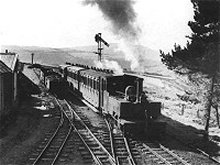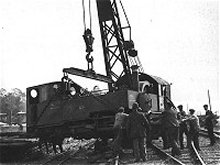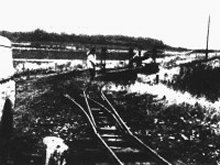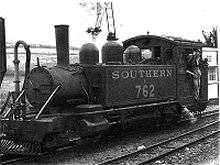L&B History
Early Days
On 17th September 1895, the first sod was cut by Lady Newnes on the site of Lynton Station. Construction took a year longer than expected and the total cost of construction was far higher than anticipated. Although it is widely reported that Nuttall's - the lead contractor - went bankrupt, this is not true and in fact they remained on site until May 1899 as part of the agreement within the contract to maintain the line for a year after construction. The company still exists today as BAM Nuttall
The first train through from Barnstaple to Lynton ran on 7th March 1898, and the "Opening Ceremony" was held on May 11th with the public service commencing 5 days later on 16th May.


The L&B was sometimes referred to as 'The Toy Railway', as the overall height of a coach was only 8'7". Its narrow gauge - 1ft 11½in. - was chosen to lower the cost of construction, since the line would be able to follow the natural contours of the countryside with curves of five chains radius. The Ffestiniog Railway had successfully made use of the same narrow gauge. The total length of the line was 19 miles with a ruling gradient of 1 in 50. Track, rolling stock and buildings were all built to high standards.
The Route
Contemporary (1900) Map (left) and modern satellite image (right) of the L&B (click images for larger view - satellite image links to "Acme Mapper" . Other online map resources, centred on Woody Bay, can be found at GeoHack)
Acquisition by the Southern Railway
The line was bought by the Southern Railway in 1923, and they carried out extensive track and infrastructure improvements. They bought a new locomotive in 1925 (Lew) and in 1927 two cranes and some new wagons.
In 1932 the SR fitted the locomotives and eight of the coaches with steam heating, but with the increase in cars and particularly buses and lorries, goods traffic or passengers continued to dwindle and closure became inevitable.


Closure
With closure imminent, the summer of 1935 brought more travellers to the line than ever. However, this could not turn the tide. On 29 September the 11.50 from Barnstaple, double headed by Lew and Yeo, was the last down train. The return from Lynton (7.55 pm) was accompanied by the playing of ‘Auld Lang Syne’, cheering crowds and whistling from the engines. The weather on the journey home fitting the occasion - it was dark and it was raining!
Perchance It "Is Not Dead But Sleepeth"
On Monday 30 September 1935, the day after the railway closed, a wreath of bronze chrysanthemums was laid on the Barnstaple Town Station stop block. Sent by Woody Bay resident Paymaster Captain Thomas Alfred Woolf, R.N. (Retired.) it bore a black-edged, hand-written card on which was written:
“To Barnstaple & Lynton Railway, with regret and sorrow from a constant user and admirer. Perchance it is not dead but sleepeth".
Auction and Dismantlement
On November 13th, an auction was held to sell of all the equipment where one of the locomotives fetched a mere £34. But apart from all the locos and two of the carriages, little was actually sold. In late 1935 Sydney Castle, a dismantler was brought in to lift the track and dispose of what had not been sold at the auction. By the summer of 1936 all the track from Pilton to Lynton had been lifted. Two carriages being left on the trackbed.
In late September the loco LEW which had been used to haul the wrecking train was dispatched to Brazil and oblivion.


Re-Birth
The present organisation was not the first formal group to consider reopening a part of the L&B. The Lynton and Barnstaple Railway Society held an inaugural meeting in March 1962 but by May, the Committee had decided that "re-opening of the complete line was obviously impossible, due to the considerable amount of expense involved". The cost of rebuilding just a part of the line from Lynton to Dean Steep was estimated at £5,000 [£75,000 at 2013 values*] a cost which was considered to be beyond the Society by itself. In 1964 only three members attended the February AGM and voted to disband the Society.
30 years of our efforts - culled from the L&B Magazine
1979: George Layton was approached by Bill Pryor (who had been a member of the Lynton & Barnstaple Society). It was considered that as there were now more railway enthusiasts living in the Lynton area, re-opening part of the L&B stood a better chance so it was decided to hold a meeting to find out. The Lynton & Barnstaple Railway Association was formally founded at the Cottage Hotel Lynton on 26th July. A Committee was duly elected for the first year, and during the summer the functions of the Association were debated. By the following August membership stood at 269.
1981: Land at Parracombe Lane Head was obtained in April for £3,100 [£7,650*] and the first working party worked on the site over the Bank Holiday weekend 24th to 25th May. As the Association was an unincorporated body it could not legally own this land so a private trust was established expressly to purchase this piece of land.
Also in 1981 there was discussion concerning charitable status as well as forming a limited company. After some time, the trackbed at Parracombe Lane Head was left and once again became overgrown.
1982: The land adjoining Woody Bay Station became available at a cost of £10,000 [£24,700*] and there was talk of a steam locomotive from North Wales being purchased.
On Tuesday 20th April, Coach 6992 was moved from Clannaborough to York. By the following year we had lost out on the land at Woody Bay station, but plans were still being discussed for the section we now operate over. However, none of this materialised and the Chairman considered it to be a very disappointing time for all concerned.
1983: Paul Gower placed an ad in the local paper advertising for relics and the new proprietors of Blackmoor Gate, Terry and Charmaine Asher, responded saying that if any relics were duplicated or were surplus, they would like to have them. Paul went to speak with them, and that became the basis of a scheme to run a railway from the pub to Wistlandpound Reservoir. Curiously, there was a similar scheme some years before – but that’s another story!
This new committee commenced encouraging discussions with a plan to get a length of track laid by Easter 1984. The other “good news” was the payment of a £500 [£1,200*] deposit from a total cost of £2750 [£6500*] for Kerr Stuart 2451 which was hoped to be in steam by September 1985. Bratton Fleming Station was up for sale at £40,000 [£94,400*]. The next year the news that the land at Parracombe Halt was probably being purchased by a local builder caused some concern.
1984: The first magazine to appear in A5 format was Number 15, Summer 1984. It was also the first magazine to have an editor. By the Autumn it was clear that the Blackmoor scheme would falter due to planning issues. The entrance to the station was not as you see it today but still used the original access road down to the back of the station buildings. The cost of the work required was estimated at £30,000 [£67,420*] which the organisation could not afford. Instead it was decided to concentrate on the Kerr Stuart, now named AXE, which by then had arrived in Devon, and also to collect the odd bits of coaches that could be found with the thought of producing a hybrid coach from all the bits.
1985: Six hundred yards of track was purchased from the Warboys Works, Huntingdon of the London Brick Works and stored at Landkey.

1986: There are 170 members. At the May AGM, trackbed negotiations were announced but not published.

1987: The Barnstaple Town Signal Box was leased for use as a museum and the original L&B turntable which had been sold to the RH&D was offered to us at the knock down price of £50 [£98*]. 1000 yards of track was obtained second-hand but in good condition from the Mowlems Carsington Aqueduct contract - 57 tons at £70 [£138*] per ton. We were also given the Pilton Crossing Gates by North Devon District Council The trackbed negotiations were then made public - later to be called "The Hole Ground Scheme." The two-part series, "The Little Train To Lynton" was shown on BBC2 for the first time.
1989: The outline planning permission for Hole Ground is submitted on the 7th March amidst opposition from a small but vociferous minority in the Raleigh locality. A year later with a vote of 20 – 3 in favour outline planning permission is granted.
1990: There is a new Magazine Editor and the membership has increased to 495.
1991: The formation of a limited company as well as a charitable trust were discussed at the annual AGM. James Evans commenced the Project to build a Manning Wardle replica - LYD.
1992: The Coach 7 project began, and NDDC offered a 125-year lease for Hole Ground on a fixed rent. Tuesday 8th September Pilton sheds are destroyed by fire.
1993: Van 23 was discovered in a field at Georgeham. The Lynton & Barnstaple Light Railway Company was incorporated on 11th August. A 2ft garden railway was purchased by two Essex Members with the intention of using it as a fund raising railway. Negotiations commenced with the owner of the Milky Way and the way was cleared for the construction of the LynBarn Railway.
1994: The Thorpe Park Railway was dismantled by members of the Surrey, Essex and Devon Area Groups, and the eight Treasure Island coaches were purchased by the Devon Group for £1,200 [£1,670*]. Construction started at the Milky Way, and the LynBarn Railway was opened by Su Pollard of Hi Di Hi fame, on Tuesday 10th May.
After a change of leadership and severe lobbying, NDDC withdrew the offer of the lease for Hole Ground. It was then discovered that Woody Bay Station could be available for sale. In the first year of operation the LynBarn Railway carried 21,000 passengers.
At the end of 1994, Woody Bay Station became available and an appeal was launched to buy the property.
1995: Sixty years after closure, the new Lynton & Barnstaple Railway takes possession of Woody Bay Station. and in June a planning application was submitted to Exmoor National Park. In October the planning application was deferred as the sub committee had doubts that the scheme would be completed. The LynBarn Railway carried 51,200 passengers and AXE was moved to the Milky Way from Landkey Yard.
1996: On March 5th the Lynton & Barnstaple Railway Company was granted planning permission to reopen part of the Lynton & Barnstaple Railway at Woody Bay. The company hoped to have trains running by Spring 1997. The Railway Company also became a “Corporate Member” of the Association of Railway Preservation Societies (now the Heritage Railway Association). Projects to build YEO and LYN were launched.
1997: The land at Cricket Field Lane was signed over to the Lynton & Barnstaple Railway Company and the Coach 17 Project was started. Membership stood at 840.
An agreement to lease more land at Woody Bay lead to an ownership dispute which consequently affected the Section 106 agreement required to modify the access road to the station . The Lynton & Barnstaple Railway Estates Company Limited was incorporated on the 23rd June. Project Yeo obtained charitable status as the Lynton & Barnstaple Railway Trust. After vandalism and several break-ins the Association decided to give up the lease on the Signal Box Museum in Barnstaple and concentrate instead on developing Woody Bay.
1998: The Lynton and Barnstaple Railway Trust was formed on the 9th May. A Centenary Dinner was held at the Valley of Rocks Hotel in Lynton and an exhibition arranged at the Barnstaple Museum which was very well received. Although the land dispute continued, the Section 106 agreement was signed. Another change of editor of the magazine. Chelfham station and the Stationmasters House, Distant Point, came on the property market for the first time in fifty years. Manning, Wardle & Company is formed as a Private Limited Company.
1999: A joint offer of £175,000 [£212,000*] for the Chelfham site by the Lynton & Barnstaple Railway Estates Company and the Distant Point Partnership was accepted. This is believed to have been the first time that a preservation group has used a time-share to purchase a station. The LynBarn Railway carried more than 70,000 passengers.
2000: Manning, Wardle & Co. announce that they were back in business and had taken over an industrial unit at Swimbridge. Work takes place on the restoration of Chelfham Viaduct. The Lynton And Barnstaple Railway Trust was Incorporated on the 25th July 2000 and it was proposed to merge the Association and the Trust.
2001: The long-running land dispute at Woody Bay was resolved. The Trust purchased a 150hp Drewry diesel from Australia, subsequently known as "PILTON". More trackbed was purchased at Woody Bay. The diesel arrived in November and was stored at the West Somerset Railway at Williton. Blue bricks were shipped from Fort Dunlop to edge the platforms at Woody Bay.
2002: The Trust purchased the remains of one of the the Howard vans. The first length of track at Woody Bay was laid in June. Some of the rail on the main line was in 15ft lengths, which was convenient as only four people were needed to lift them into place, rather than the eight required for a 30ft length. Luckily that year there was little rain. Members of the Tallylyn Railway and the Isle of Wight Railway also helped with tracklaying.
2003: Van 23 arrived at Woody Bay as did steam loco EMMET. The railway opened as a visitor centre on the 11th May: the 105th anniversary of the opening of the line. An L&B 4 ton goods van was discovered. AXE was moved from the Milky Way to the Gartell Light Railway in Somerset.
2004: A 65hp diesel hydraulic loco is loaned to the L&B by the Woodthorne Colliery Museum, and renamed EXMOOR RANGERr. One of the Alan Keef coaches built for the Thorpe Park Railway and then at the LynBarn was reconstructed for use at Woody Bay in the Trust's Bratton Fleming workshop. The rolling stock shed was erected and the interior of the station refurbished. The first passenger hauled train since 1935 left Woody Bay on the 12th July 2004. Edmund Nuttall Ltd. agreed to rebuild Bridge 67. Coach 7 returned to Woody Bay, albeit minus bogies.
2005: The first steam hauled passenger train, hauled by PETER PAN, left Woody Bay on Sunday 12th March with a one-coach train. A second carriage arrived later. BRONLLWYD was the first resident steam loco. HOLWELL CASTLE entered service. Bridge 67 was completed. The L&B held its first gala, on 29th September. In October, tracklaying to Killington Lane was started. On 31st October the LynBarn Railway ran its last train in L&B ownership as after 12 years, it was being sold to the Milky Way.
2006: In January HEDDON HALL entered service. Tracklaying to Killington Lane was completed. in April. Hunslet’s STATFOLD joins BRONLLWYD at Woody Bay. PILTON the Baguley Drewry went to Statfold Barn for restoration. By the end of May train services were running to Killington Lane Halt. Coach three entered service in July.
2007: At an EGM held in March the membership unanimously agreed that the ownership of the railway should pass to the Trust and that the Estates Company as a subsidiary of the Trust should become the operating company and also convert to a Community Interest Company to be known as the Lynton & Barnstaple Railway CIC. In April, Maffei 4127 arrived in North Devon and entered revenue earning service as SID, just as BRONLLWYD’s boiler ticket ran out in July.
2008: The bogies for Van 23 arrived at Woody Bay in January. Work started on the toilet block in February, as well as the complete refurbishment of the kitchen to satisfy modern environmental health requirements. The station had operating signals for the first time since restoration began. The Surrey Group completed the essential water tank project. The headshunt was re-laid and the last short lengths of 50lb rail were re-laid through the station. Coach 4 arrived. AXE, the Trust's own steam locomotive, arrived at Woody Bay and was dedicated on 11th November.
The toilet block was completed. After the abandonment several years ago of the LYN Project, the 762 Club to build a replica LYN was announced.
2009: In February, the 40lb points at the engine shed end were replaced with 50lb points re-gauged by volunteers in the car park. AXE entered revenue earning service on 1st March, and for the first time the L&B owned a complete train. The “missing link” to Parracombe was purchased by Exmoor Associates. The running shed was extended by a third to include a workshop. Jack Baker - the man who sold us Woody Bay in 1995 dies at the age of 92 on March 11th. Membership stands at over 2000.
(* present-day equivalent values are based on The UK Inflation Counter at https://www.moneysorter.co.uk/calculator_inflation2.html and were generated in February 2013)
In the very first newsletter from November 1979 there appeared the following paragraph:
At present we would like to operate a section of the railway, between Blackmoor Gate and Lynton, of no less than a mile in length, with a view towards purchasing other sections of trackbed in due course. We may be able to obtain the use of ½ mile of line, with running powers into the Down Platform at Woody Bay Station eventually. This would mean that we would have room for running the engine forward "off' it's train and reversing round a loop and back on the other end. Beyond the station towards Parracombe there would be room for storing rolling stock in at least two sidings. Together with an engine shed. The countryside is completely unspoilt just here and would be ideal for attracting both enthusiasts and the tourists.
Why has it taken so long?
What has to be considered is that unlike the lines closed in the 50s and 60s, which usually had inherited at least the residue of an operational railway with track still laid and rolling stock and equipment available, the L&B had been totally removed from the landscape, with only the earthworks and station buildings remaining. Also, many of those involved back then had no idea that it was just not feasible to rebuild the entire railway on the proceeds of selling pens and T-shirts at fetes, model railway exhibitions and traction engine rally’s.
The turning point was the opening of the LynBarn Railway in 1994. To quote L&B founder member Paul Gower “When we laid the track at The Milky Way, the biggest track I had ever laid was 00! For the cost of a bit of diesel, we could make £100 in a day. Without the LynBarn, there would be no Woody Bay or Chelfham.”
.
Against all the odds and the many who said it could not be done, it has been done. It may have taken 30 years+ but Phase 1 is now completed and Woody Bay is a wonderful location and the public certainly appreciate that North Devon is one of the most beautiful locations in the World for a narrow gauge railway.
Having got this far you would think it would get easier, but reinstating the railway to Blackmoor and Wistlandpound and then back to Lynton is even more demanding in terms of planning and the necessary sizeable funds.
To-date the new L&B has accomplished every goal and overcome every challenge that has been set before it.
We have shown that given the necessary support and financial backing, we have the ability to achieve the complete restoration of the legendary Lynton and Barnstaple Railway.
“Perchance it's awake!”
Renaissance: a New L&B
Once Woody Bay Station was secured in 1995, over the following years the newl Lynton & Barnstaple Railway Company and the supporting L&BR Trust negotiated the purchase of all the adjoining land and progressed construction to make the operational railway you see today.
Our current aim is focussed on the operations at Woody Bay whilst expanding/extending the railway to Blackmoor, Wistlandpound and beyond.
In furtherance of this aim, several sections of land and also certain properties have been purchased contributing to our goal of obtaining access of all the trackbed required to operate trains between Woody Bay and Wistlandpound for which we have the necessary planning permissions.
Once that is achieved, the section from Woody Bay to Lynton will be undertaken - we already own land in this section with more to come.
With your support we can make sure that future generations will once again be able to enjoy this jewel in the crown of English narrow-gauge railways.
Locomotives
The L&BR locos were very distinctive in their appearance.
YEO, EXE and TAW - the three original locos built by Manning Wardle of Leeds - were 2-6-2 tank engines.
LYN - built by Baldwins of Philadelphia (USA) - was a 2-4-2 tank and entered service in July 1898.
LEW - the fourth loco - was also a Manning Wardle, bought by the SR in 1925.
After the auction in 1935 YEO, EXE, TAW and LYN were all scrapped. LEW, however was retained to dismantle the line, and later shipped to Pernambuco Brazil aboard the SS Sabor. Despite numerous searches for this historic loco, it has never been found.
Read more about the Mystery of Lew


Further Reading
The Lynton & Barnstaple Railway shop at Woody Bay Station sells several books for those who want to read the more detailed history of the railway. We are lucky that so many photos were taken of the line while it was running. There is also a surprising amount of cine film.
There are also a number of linked articles about various aspects of the L&B on Wikipedia.
Books, models, and other L&B merchandise can also be purchased from our Online Shop!

























